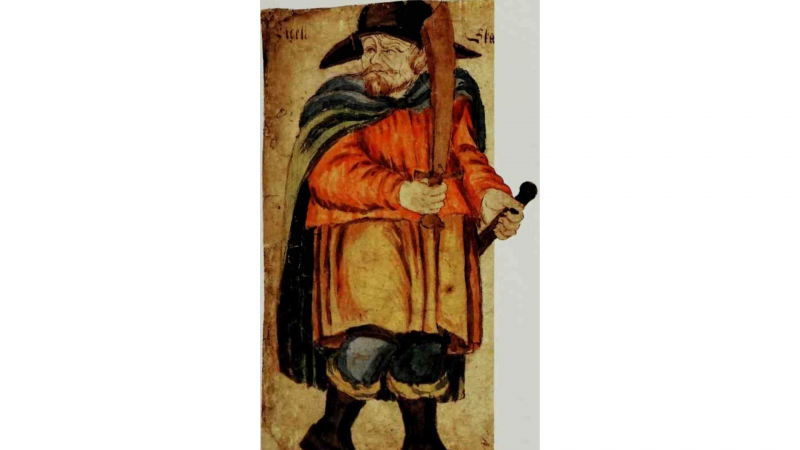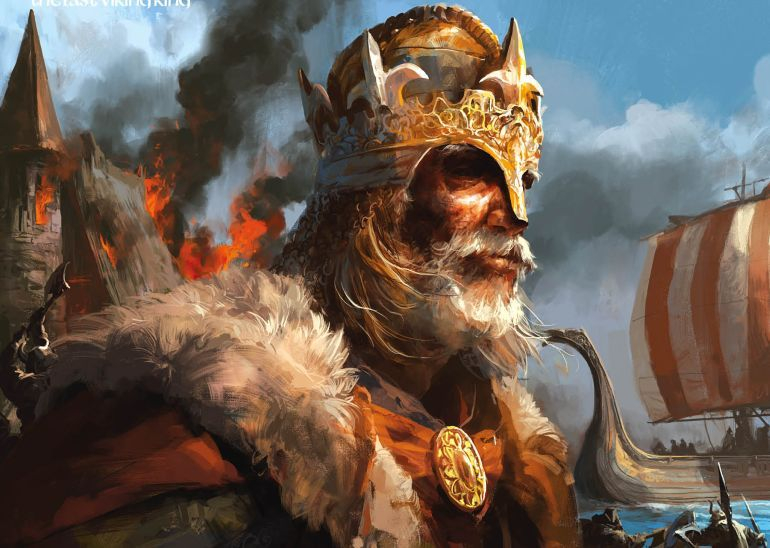Top 10 Most Famous Vikings of All Time
The Vikings are widely thought to have lived between 700 AD to 1100 AD, a period during which they engaged in an astounding amount of plundering and raiding ... read more...and established an unrivaled reputation for ruthless violence. Let's explore who are the most famous Vikings of all time with Toplist through this post!
-
First one in the list of the most famous Vikings of all time is Erik the Red. Erik the Red, often known as Erik the Great, is a character who more than most personifies the ferocious reputation of the Vikings. Due to the color of his hair, Erik was given the nickname Erik the Red. Erik eventually founded Greenland, but only after being expelled from Iceland for killing several men. Erik's father, Thorvald Asvaldsson, had been banished from his native Norway for manslaughter, thus it was evident that violence and exile ran in the family. Erik (actual name Erik Thorvaldsson) earned the nickname "Erik" due to his aggressive personality and long, wavy red hair. He was credited with founding the first settlement in Greenland according to historical and Icelandic saga traditions. He was born in the Jaeren neighborhood of Rogaland, Norway, as the son of Thorvald Asvaldsson, according to Icelandic sagas. Leif Erikson, a well-known Icelandic explorer, was one of Erik's sons.
The Icelandic sagas claim that earlier Norsemen may have discovered and attempted to inhabit Greenland before Erik, despite the fact that popular history claims he was the first to do so. Tradition attributes the discovery of the land mass to Gunnbjörn Ulfsson, also known as Gunnbjörn Ulf-Krakuson. Strong winds had pushed Gunnbjörn toward the region he termed Gunnbjörn's skerries over a century before Erik. However, Gunnbjörn has received little attention in the history of Greenland because of the discovery's unintentional nature. Snaebjörn galti had also traveled to Greenland after Gunnbjörn. Galti was in charge of the first unsuccessful Norse attempt to colonize Greenland, according to historical records. Erik the Red, however, was the first permanent European occupant.

Photo: ThoughtCo 
Photo: The Viking Herald -
Leif Erikson, sometimes known as Leif the Lucky, was a Norse adventurer who is believed to have been the first European to set foot on North American soil, about 500 years before Christopher Columbus. His full name is Leif Erikson, Leiv Eiriksson, or Leif Ericson. He founded a Norse settlement at Vinland, which is typically thought to be coastal North America, according to Icelandic sagas. There is persistent suspicion that the settlement established by Leif and his company is related to the ruins of a Norse settlement named L'Anse aux Meadows, which were discovered in Newfoundland, Canada, and was inhabited 1,000 years ago (carbon dating estimates 990–1050 CE). Erik the Red, who established the first Norse settlement in Greenland, and Thjodhild of Iceland were the parents of Leif. Although his birthplace is unknown, it is likely that he was born in Iceland, which had just lately been settled by Norsemen, primarily from Norway.
Since Leif's successful mission in Vinland inspired other Norsemen to follow in his footsteps, they were the first Europeans to settle the region. A bill designating October 9 as "Leif Erikson Day" in Wisconsin was passed by the state legislature in 1929. The United States Congress authorized and requested the president to proclaim October 9 as "Leif Erikson Day" each year in 1964. On October 6, 2000, President Bill Clinton issued Presidential Proclamation 7358, designating Monday, October 9, 2000, as Leif Erikson Day.

Photo: Pinterest 
Photo: All That's interesting -
Freydís Eiríksdóttir (born around 975) was a Norse woman who was reputed to be the daughter of Erik the Red, who played a significant role in the Norse exploration of North America as an early colonist of Vinland. Her brother, Leif Erikson, is credited in early histories of the area with making the first European contact. The two Vinland sagas, the Saga of the Greenlanders and the Saga of Erik the Red, are the medieval and primary sources that discuss Freyd's. Although the two sagas provide different perspectives, Freyd's is portrayed in both as a powerful woman. Freydís Eiríksdóttir is also considered as one of the most famous Vikings of all time.
Both sagas list Freydís as one of the explorers, but they each give a different narrative of who she was. In one, while carrying a large baby, she frightens away a bunch of attackers by brandishing a sword. In the other, she killed a bunch of helpless ladies in cold blood while being cunning and vicious. Freyd's actions are astounding in all of the stories, but regardless of how she is portrayed—positively or negatively—her steely personality permeates them both.
After The Saga of the Greenlanders, The Saga of Erik the Red was written. The half-sister of Leif Erikson, Freyds is portrayed in this story as a renowned and powerful woman. She joined an expedition to Vinland under the command of Orfinnr Karlsefni, but she only appears once in the saga during an attack by natives. The Indians sneaked up on the expedition's camp at night and fired at the warriors while armed with "war-slings, or catapults". The reports of what happened to the Norse in Vinland are given in rough form in The Saga of the Greenlanders. Chapter 8 of this tale recounts Freyd's adventures in Vinland and identifies her as Leif Erikson's full sister.

Photo: Historian's Hut 
Photo: Naked History -
According to tales, Ragnar Lodbrok was a Danish and Swedish king as well as a legendary Viking hero. He is well-known thanks to Viking Age Old Norse poetry, Icelandic sagas, and almost contemporaneous chronicles. The traditional literature claims that Ragnar distinguished himself by leading numerous attacks during the ninth century against the British Isles and the Holy Roman Empire. Additionally, he is mentioned in Norse mythology. In Tale of Ragnar's Sons and a Saga of Certain Ancient Kings, Ragnar Lodbrok's father is identified as Sigurd Ring, a mythical Swede king.
Ragnar was the son of the Swedish king Sigurd Ring, according to the Tale of Ragnar Lodbrok, Tale of Ragnar's Sons, Heimskringla, Hervarar saga of Heireks, Sögubrot af nokkrum fornkonungum, and numerous other Icelandic sources. Almost all of the sagas concur that Sigurd's father was the Danish king Randver, and the Hervarar saga names his spouse as sa, a Norwegian royal descendant named King Harald with the Red Moustache. According to several tales, Randver was a descendant of famous Scandinavian king Ivar Vidfamne through his daughter Aud (whom the Hervarar saga calls Alfhild). Following the death of king Ivar Vidfamne, Aud's eldest child with Danish king Hroerekr Ringslinger, Harald, anointed himself Harald Wartooth and seized control of the entire realm.
The brutal Norse King Ywar and his brothers, Inguar (a doppelganger of Ywar), Ubbi, Byorn, and Ulf, who dominate the northern peoples, are mentioned as being the children of Lodbrok (Lothpardus) in the Chronicon Roskildense (about 1138) as their father. The Viking invasion of the West Frankish realm culminated in the Siege of Paris and the Sack of Paris in 845. "Reginherus," also known as Ragnar, was the Norse chieftain who commanded the Viking army. This Ragnar has sometimes been tentatively linked to the legendary saga character Ragnar Lodbrok, however scholars question the veracity of this claim.

Photo: Wikipedia 
Photo: Wikipedia -
Björn Ironside is the following most famous Viking of all time. According to Norse mythology, Björn Ironside was a Swedish king as well as a Norse Viking commander. His life is dated between 855 and 858 in the Scandinavian history of the 12th and 13th centuries. He was the son of infamous Viking king Ragnar Lodbrok. According to legend, Björn Ironside founded the Swedish Munsö dynasty. Antiquarians asserted that a barrow on the island of Munsö was Björn Järnsidas hög, or Björn Ironside's barrow, in the early 18th century. Björn Ironside's sons and grandsons, notably Erik Björnsson and Björn at Haugi, are mentioned in medieval texts. According to Icelandic sagas, Björn was a member of the royal house of Munsö, which governed Sweden until around 1060.
Strong Viking chieftain and naval commander "Berno" was. He can be found in recent publications like the Chronicon Fontanellense and Annales Bertiniani. It was the summer of 855 when he was first mentioned. The Norman history of William of Jumièges is the first book that describes his ancestry (c. 1070). Hastein, Björn Ironside, and maybe one or more of his brothers co-led a significant Viking invasion into the Mediterranean in 859–861, according to a variety of Frankish, Norman, Arab, Scandinavian, and Irish sources. The Norsemen plunder the south of France where the fleet spent the winter before setting foot in Italy where they conquer the city of Pisa. This occurs after they have raided down the Iberian coast and forced their way through Gibraltar. During the Mediterranean voyage, the Vikings are said to have lost 40 ships to a storm while riding high on this victory and others they had around the Mediterranean. According to William of Jumièges' later account of the mission, Björn Ironside served as the expedition's commander.
Throughout the Middle Ages, various versions of the tale of Björn and his brothers who are the sons of the Scandinavian monarch Ragnar Lodbrok were told. The Tale of Ragnar's Sons, also known as Ragnarssona áttr, is an Icelandic Fornaldar Saga from around the fourteenth century that combines mythological elements with conventional Norse oral history. According to the information given, Björn was the child of Ragnar and Aslaug and had three brothers named Hvitserk, Ivar the Boneless, and Sigurd Snake-in-the-Eye. Eric and Agnar, Björn's half-brothers, are also mentioned in the story.

TV Program Vikings (Photo: Georgia Online) 
Photo: ArtStation -
Icelandic chieftain Gunnar Hámundarson lived in the tenth century. He was born in Hlíðarendi, Fljótshlíð and is probably better known by his middle name, Gunnar. He plays a significant role in the first half of the Njáls epic, which describes the series of circumstances that ultimately resulted in his death in combat.
Gunnar was a legendary warrior who was said to be almost unbeatable in battle. He was described as a strong, athletic guy who was "capable of jumping his own height in full body armor, both back and front" in the Njáls saga. He was a proficient archer, and when it came to close quarters, he preferred the atgeir, which experts believe to have been some type of halberd or glaive. On a Viking raid to the island of Eysýsla, he is claimed to have taken this renowned weapon in combat from a man by the name of Hallgrmur.
Gunnar was a strong swimmer as well as a skilled stone thrower, capable of striking opponents between the eyes from a distance of several meters. It was said that he had no equal in any game. Being a drinker, he was believed to love the finer things in life. He was usually friendly and mild-mannered, but his manner of speaking did not give the impression that he was an intellectual man. He gave good counsel and was always polite but forceful. However, Gunnar's insightful observations and profound comprehension strongly implied that he was as intelligent as he was attractive. He kept pleasant company and was dependable to his friends. He was hailed as the most attractive man in the entire globe, without peer.

Photo: BabaMail 
Photo: Norse and Viking Mythology -
The semi-legendary Viking leader Ivar the Boneless, also known as Ivar Ragnarsson, attacked England and Ireland. He was the son of Ragnar Lodbrok and his wife Aslaug, according to the Tale of Ragnar Lodbrok. Björn Ironside, Hvitserk, Sigurd Snake-in-the-Eye, and Ubba were some of his brothers. Ivar and Mar are likely the same person. It's unclear where the moniker first appeared. "Ivar beinlausi'' can be translated as "Ivar legless," but "beinlausi" can also mean "boneless" in English because "bein" is the same word in Old Norse as "bone" and "leg." A line in Ragnarssona þáttr (also known as the tale of Ragnar's sons) suggests it refers to male impotence. Several of the sagas mention him as lacking legs/bones or having a skeletal ailment like osteogenesis imperfecta.
Ivar was allegedly the son of Danish king Ragnar Lothbrok, yet nothing is known about his early years. Some sources claim that he served as the expedition's commander in 855 while it was stationed on an island close to the Thames River's mouth. He was Olaf the White's companion in various wars fought on the island of Ireland in the 850s. Olaf the White is remembered in history as the Danish king of Dublin. Ivar and Olaf campaigned and pillaged in the county of Meath in the early 860s after forming brief agreements with a number of Irish kings, including Cerball, king of Ossory. Ivar passed away in 873 and was formerly referred to as "king of the Norsemen of all Ireland and Britain." That's all about the seventh most famous Viking of all time we want to mention.

Photo: The Famous People 
Photo: The Viking Herald -
Eric Haraldsson, also known as Eirik fratrum interfector (Eirik Brother-Bane), was a king of Norway in the tenth century and went by the moniker Eric Bloodaxe. It is usually believed that he served brief times as both the King of Northumbria and the King of Norway (c. 947–948 and 952–954). In accordance with the vivid Icelandic sagas, he started his Viking career at the age of 12. He met and wed Gunnhild, a witch who was the Danish king's daughter, during one of his expeditions.
The sagas describe how Eric, who succeeded his father as king of Norway following his death, assassinated four of his elder brothers in order to retain the throne. But after being deposed by his younger brother, he fled to Britain and was crowned king of Northumbria, reigning from a palace in York. Different Norse sagas describe Eric's initial journey to Britain after being driven out of Norway in different ways. The most succinct accounts are found in the synoptic histories. Theodoricus jumps right to Eric's entry into England, King Thelstan's reception of him, Eric's brief rule, and his quick demise.
From the meager historical information that is now accessible, historians have created a narrative of Eric's life and career. There is a difference between sources that are current or very current for Eric's reign over Northumbria and sources that are wholly dependent on sagas that provide information on the life of Eric of Norway, a chieftain who governed the Norwegian Westland in the 930s. Heimskringla claimed that Harald had designated his sons as client kings over the several provinces of the country and had planned for his favorite son, Eric, to succeed him when he passed away.

Photo: Ancient Origins 
Photo: Royals in History -
Egil Skallagrmsson definitely deserves a place in the list of the most famous Vikings of all time. Egil Skallagrmsson was a war poet, magician, berserker, and farmer during the Viking Age. He is well known for playing the antagonist in Egil's Saga. It is thought that Egil's Saga, which historically covers the years 850 to 1000 AD, was composed between 1220 and 1240 AD.
Egill is portrayed in the epic as having a dual temperament that results from his mixed ancestry with fair, outgoing Vikings and dark, reticent Sami. He was obstinate, vindictive, and eager for gold, but he was also a dependable friend, a reserved lover, and a loving parent. He murdered King Eiríkr Bloodaxe's (Erik I) son when he was a young man and cursed the monarch by writing magic runes on a pole. He was later shipwrecked off the coast of Northumbria, England, and came into the hands of Eiríkr, but he was able to spare his own life by writing the lengthy ode Höfuthlausn ("Head Ransom") in a single night and praising Eiríkr in a special end-rhyme meter. He is also credited with writing the lengthy praise poem Arinbjarnarkvitha ("Lay of Arinbjörn '').
As soon as two of his boys passed away, Egill secluded himself in his walled bed and stopped eating. In response to pressure from his daughter, he wrote the intensely personal lament Sonatorrek (also known as "Revenge Denied" or "Loss of Sons"). Egill finished the poem and went back to his regular routine. He lived long enough to write a lament about his senility while also being old and blind.

Photo: Viking history 
Photo: Throwback Thorsday -
The sagas give Harald Sigurdsson, also known as Harald of Norway (c. 1015 – 25 September 1066), the title Hardrada, which roughly translates as "stern counsel" or "hard ruler." From 1046 to 1066, he ruled Norway (as Harald III). He also attempted to usurp the English crown in 1066 and the Danish throne until 1064. Harald had spent about fifteen years in exile as a military leader and mercenary in Kievan Rus' and of the Varangian Guard in the Byzantine Empire before he became king.
In 1046, Harald allied himself with pretender Sweyn II of Denmark, the adversary of Magnus in Denmark (Magnus had already attained the throne of that nation), and together began to invade the Danish coastline. At home, Harald overthrew all local and regional opposition and detailed the territorial unification of Norway under a centralized government. The reign of Harald was probably marked by a fair amount of peace and stability, and he established a strong coin economy and foreign trade. Harald also claimed the Danish crown and spent nearly every year up to 1064 ravaging the Danish coast and battling Sweyn, his old ally, likely in an effort to revive Cnut's "North Sea Empire." Despite having strong campaigns, he was never able to take over Denmark.
The former Earl of Northumbria, Tostig Godwinson, brother of the newly crowned English king Harold Godwinson (also known as Harold of Wessex), pledged his allegiance to Harald and extended an invitation for him to ascend to the English throne not long after Harald had renounced his claim to Denmark. Along with 10,000 soldiers and 300 longships, Harald invaded Northern England in September 1066, carried out a coast attack, and on September 20, 1066, he beat the Northumbria and Mercia regional English forces. The Battle of Stamford Bridge took place on September 25, 1066, and despite Harald's initial success, Harold Godwinson's men surprised him, murdered him, and nearly destroyed his whole army. The Viking Age was said to have come to an end when Harald died, putting a halt to his invasion.

Photo: The History Avenue 
Photo: Pinterest































